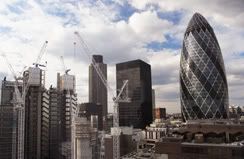UTOPIAN DESIGN
It is said to be London's first environmentally sustainable skyscraper. Its design was inspired by the ideas that were used in the Climatroffice design with Buckmister Fuller in the 1970s. It in turn has moved sustainability forward in the construction industry and has inspired the designs of other buildings, including Foster’s Hearst Tower in New York.
This building consumes 50% less energy than a typical skyscraper.
Low consumption of energy is achieved due to the diagrid structure, a grid of diagonally interlocking steel elements, used in its construction. Energy saving methods that are used in this building not only allows the building to use half the power that a similar tower would typically consume, but also provides pleasant and refreshing environment to its occupants.
Each floor of this building has gaps which creates several shafts. These shafts are useful for several purposes, such as they serve as a natural ventilation system for the entire building; they create a giant double glazing effect; air is sandwiched between two layers of glazing and insulates the office space inside.
The shafts drag the warm air out of the building in summers and this process warms the building in the winter, this process takes place using passive solar heating. These shafts perform another operation that allows sunlight to pass through the building, which saves energy and it keeps the lighting costs down, while making the work environment more pleasing.
This building has spiralling light wells that allow daylight to flood down onto the floors, as well as being an integral part of the ventilation strategy and saves up to 40% of the year. This allows the building to operate without full air conditioning at certain times of the year.
The building’s unique form is a response to the constraints of its site. Its shape appears less bulky than a rectangular block, creating public space at street level. It also offers minimal resistance to wind, improving the environment for people on the ground and reducing the load on the building.
The slim base and top also reduce reflections and improve transparency, and the floor-to-ceiling windows improve daylight penetration over a conventional building. The building’s shape also means that it does not need extra reinforcements to add stiffness to resist wind load. The shape of the structure provides the stiffness required.
This unique structure has been admired due to its revolutionary style utopian approach. If all the building are like Gerkin, a lot of energy will be saved while people can enjoy the designs.

images taken from google images.

images taken from google images.
No comments:
Post a Comment